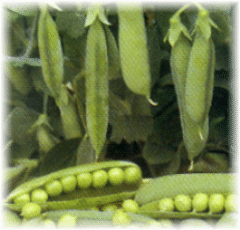 Garden
Peas Come In All Sizes & Shapes
Garden
Peas Come In All Sizes & Shapes
Vol.2 #108
February 23, 2001
 Garden
Peas Come In All Sizes & Shapes
Garden
Peas Come In All Sizes & Shapes
The two vegetables which can safely be planted throughout February are peas and onions. Most other cool season things should be planted in mid March to avoid germination followed by a deep freeze. Peas and onions can handle the cold dips of March. I have heard of folks in the Frederickburg area planting peas in early December with some degree of success. If you try this early planting method, use an early variety of pea which is generally smooth. The lack of "wrinkle dimples" prevents water from standing on the surface of the seed as it sleeps through the winter, anticipating an early spring germination. Just as earlier varieties are more cold tolerant, there are later varieties that are more heat tolerant. Peas do not do well in hot weather, so plant between mid February and mid April.
The earliest studies of genetics done by Gregor Mendel were comparisons of growth habits of various peas. It's been about 25 years, but if I recollect correctly, the tall climbing pea vine was dominant and the shorter pea vine was recessive. The point is garden peas come in many sizes and shapes. Regarding growth habit, the taller the vine the more likely it will need physical support of stakes or a trellis. Climbing vegetables yield more fruit in a smaller area, but some effort and expense is required to construct supports. Low growing vines or "bush" vegetables usually require no supports - just plant them and let them grow.
There are a few classes of peas which include "English peas", "Snowpeas", and "Edible Pod Peas". The English pea is the traditional green pea which is shelled from its pod prior to freezing, canning, or eating. The Snowpea is used in Chinese stir fry cooking for the pod. If the Snowpea pod is allowed to develop mature peas, they will be as hard and as inedible as BB's, so pick them before they fill. The Edible Pod Pea (or "Sugar Pea") is like an English pea except that the pod itself is quite sweet and edible.
All peas are legumes which means that their roots harbor nodules of bacteria which collect nitrogen from the atmosphere. Legumes are great for building your soil because they are rich in nitrogen. You should not use high nitrogen fertilizers on peas because they fetch their own, however, you can purchase inoculants to treat your seeds in order to insure that the plant has plenty of the nitrogen fixing bacteria which is commonly found in the soil. Think of this as Acidopholis Milk for peas.
We have all of our varieties of peas on our Shopping Cart under the Vegetable
Section. For early peas, try Frosty or Early Alaska.
For short vines with a large pea, try Laxton Progress #9. Sugar
Snap is a tall, climbing Edible Pod Pea and Cascadia is a good
low growing "bush" Edible Pod pea. Use Dwarf Grey Sugar Peas
as a bush snowpea, often referred to as Chinese Snowpeas. For late
planting and heat resistance, Wando is an old standby and
Green
Arrow is excellent. Having said all of this, I'll leave you with
one of my favorite old sayings. "I eat my peas with honey.
I've done it all my life. I know it may sound funny, but it keeps
them on my knife!"
Andy Lynn